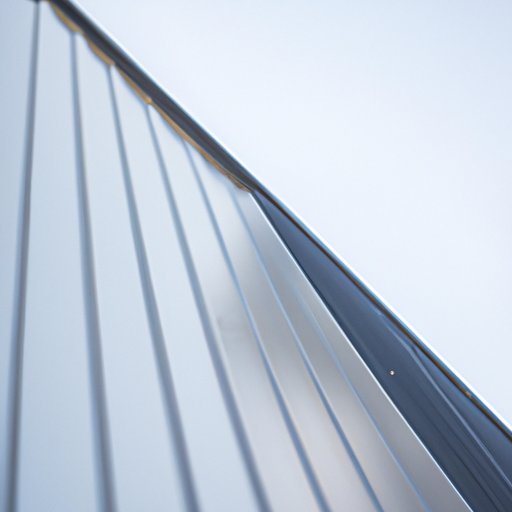Introduction
Aluminum composite panel (ACP) is a type of flat panel made from two thin layers of aluminum bonded to a polyethylene core. It is lightweight and durable, making it an ideal material for many different kinds of applications. ACP is often used in exterior cladding, interior design, and signage. This article will explore the benefits and uses of ACP, discuss different types, look at how architects use ACP in their projects, analyze the environmental impact of ACP, provide installation tips, and consider factors to consider when choosing an ACP.

Types of Aluminum Composite Panels
ACPs come in a variety of colors, finishes, and sizes. The most common types are solid, metallic, brushed, and mirrored. Solid ACPs are the most basic type and are available in a range of colors. Metallic ACPs have a glossy finish that can be used to create an eye-catching effect. Brushed ACPs have a matte finish that gives them a more subtle appearance. Mirrored ACPs are highly reflective and can be used to create an interesting visual effect.
ACPs are also available in a range of thicknesses. The most commonly used thicknesses are 4mm and 6mm. Thicker ACPs are also available, up to 10mm, which can be used for more robust applications. ACPs can also be customized with decorative elements, such as perforations or cutouts.
ACPs can be used in a variety of applications, including exterior cladding, interior design, and signage. They are often used as rainscreens on the outside of buildings, providing protection against wind and rain while also adding a modern aesthetic. ACPs can also be used as interior wall cladding, offering a sleek and modern look that is easy to maintain. They are also commonly used as signage, allowing businesses to display logos and other information in a visually appealing way.
Architects and Aluminum Composite Panels
Architects often use ACPs in their projects due to their versatility and durability. ACPs can be used for both interior and exterior applications, and they are easy to install and maintain. ACPs are also lightweight, making them easier to transport and install than heavier materials. Additionally, ACPs offer superior insulation, helping to keep buildings cool in the summer and warm in the winter.
ACPs are also aesthetically pleasing. They come in a variety of colors, finishes, and sizes, allowing architects to create unique designs. ACP is also cost-effective, making it an attractive option for many architectural projects. Finally, ACPs are resistant to corrosion, making them ideal for use in areas with high levels of moisture.

Environmental Analysis of Aluminum Composite Panels
The environmental impact of ACPs must be considered when assessing their suitability for a project. ACPs are made from aluminum, which is a non-renewable resource. However, ACPs are recyclable, meaning that they can be reused after their initial use. Additionally, ACPs are energy efficient and require little maintenance, making them a more sustainable choice than other materials.
When considering the environmental impact of ACPs, it is important to consider the entire life cycle of the product. From production to disposal, ACPs should be produced, used, and disposed of responsibly. Additionally, careful consideration should be given to the manufacturing process, as this can have an impact on the environment.
Installation Tips for Aluminum Composite Panels
Installing ACPs requires careful preparation and attention to detail. Before beginning the installation process, the area should be thoroughly cleaned and all necessary materials should be gathered. ACPs should also be stored in a dry, well-ventilated area. During installation, ACPs should be handled carefully, as they can be easily damaged. All edges should be sealed and any gaps should be filled to ensure a secure fit.
The installation process should be done carefully and professionally. ACPs should be attached to the substrate using the appropriate fixings. It is important to follow the manufacturer’s instructions for installation. Once the ACPs are in place, they should be inspected to ensure that there are no gaps or defects. Any gaps or defects should be addressed before proceeding with the installation.

Choosing the Right Aluminum Composite Panel
When choosing an ACP for a project, there are several factors to consider. First, the application should be taken into account. Different types of ACPs are best suited for different applications. For example, solid ACPs are best for exterior cladding, while metallic ACPs are better suited for interior design. Additionally, the size and shape of the ACP should be taken into account. The right size and shape can make a big difference in the overall look of the project.
Customizing your ACP can also be beneficial. Customizing allows you to tailor the ACP to your specific needs and preferences. You can choose the color, finish, size, and shape of the ACP, as well as add decorative elements such as perforations or cutouts. Customizing your ACP can help you create a unique and attractive design.
Conclusion
ACPs offer a wide range of benefits, making them an ideal material for many applications. They are lightweight, durable, and aesthetically pleasing, and they are available in a variety of colors, finishes, and sizes. ACPs are also cost-effective and energy efficient, and they can be customized with decorative elements. When considering ACPs, it is important to take into account the environmental impact, as well as proper storage and handling during installation. Additionally, it is important to consider the different factors when choosing an ACP for a project.
Overall, ACPs offer a wide range of benefits and can be used in a variety of applications. They are an excellent choice for architects looking to create unique and attractive designs. With proper storage, handling, and installation, ACPs can provide long-lasting and aesthetically pleasing results.

